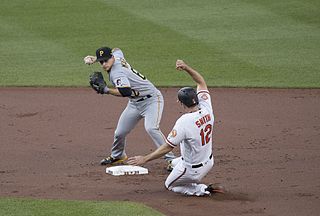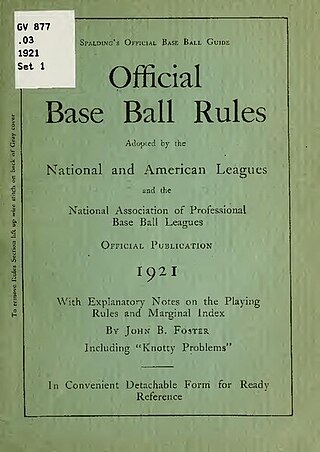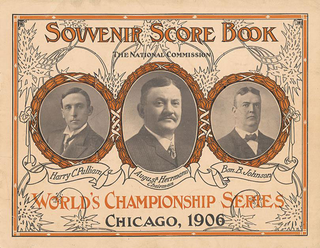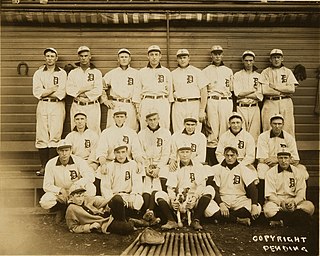
In baseball, a home run is scored when the ball is hit in such a way that the batter is able to circle the bases and reach home plate safely in one play without any errors being committed by the defensive team. A home run is usually achieved by hitting the ball over the outfield fence between the foul poles without the ball touching the field.

In baseball and softball, a double play is the act of making two outs during the same continuous play. Double plays can occur any time there is at least one baserunner and fewer than two outs.

In baseball and softball statistics, an error is an act, in the judgment of the official scorer, of a fielder misplaying a ball in a manner that allows a batter or baserunner to advance one or more bases or allows a plate appearance to continue after the batter should have been put out. The term error is sometimes used to refer to the play during which an error was committed.

Extra innings is the extension of a baseball or softball game in order to break a tie.

Throughout the history of baseball, the rules have frequently changed as the game continues to evolve. A few common rules most professional leagues have in common is that four balls is a base on balls, three strikes is a strikeout, and three outs end a half-inning.

A box score is a chart used in baseball to present data about player achievement in a particular game. An abbreviated version of the box score, duplicated from the field scoreboard, is the line score. The Baseball Hall of Fame credits Henry Chadwick with the invention of the box score in 1858.

Charles Joseph Hiller was an American Major League Baseball second baseman. In the 1962 World Series, he became the first National League player to hit a grand slam in a World Series.

The 1926 World Series was the championship series of the 1926 Major League Baseball season. The 23rd edition of the Series, it pitted the National League champion St. Louis Cardinals against the American League champion New York Yankees. The Cardinals defeated the Yankees four games to three in the best-of-seven series, which took place from October 2 to 10, 1926, at Yankee Stadium and Sportsman's Park.
The 1932 World Series was the championship series in Major League Baseball for the 1932 season. The 29th edition of the World Series, it matched the American League champion New York Yankees versus the National League champions Chicago Cubs. The Yankees won in a four-game sweep. By far it is mostly noteworthy for Babe Ruth's "called shot" home run, in his 10th and last World Series. It was punctuated by fiery arguments between the two teams, heating up the atmosphere before the World Series even began. A record 13 future Hall of Famers played in this World Series, with three other future Hall of Famers also participating: umpire Bill Klem, Yankees manager Joe McCarthy, and Cubs manager Rogers Hornsby. It was also the first World Series in which both teams wore uniforms with numbers on the backs of the shirts.

The 1906 World Series was the championship series in Major League Baseball for the 1906 season. The third edition of the World Series, it featured a crosstown matchup between the American League champion Chicago White Sox and the National League champion Chicago Cubs. The Cubs had posted the highest regular-season win total (116) and winning percentage (.763) in the major leagues since the advent of the 154-game season. The White Sox, known as the "Hitless Wonders" after finishing with the worst team batting average (.230) in the American League, beat the Cubs in six games for one of the greatest upsets in Series history as the Sox out-pitched the Cubs in their first two wins and out-hit them in their last two. The home teams alternated, starting with the National League Cubs being home in Game 1.

Stanley Camfield Hack, nicknamed "Smiling Stan", was an American third baseman and manager in Major League Baseball who played his entire career for the Chicago Cubs and was the National League's top third baseman in the late 1930s and early 1940s. Usually a leadoff hitter, he batted .301 lifetime, scored 100 runs seven times and led the NL in hits and stolen bases twice each. His 1092 walks ranked fourth in NL history when he retired, and remain a franchise record; he also hit .348 in the World Series, which he competed in four times. His .394 career on-base percentage was the highest by a 20th-century third baseman until Wade Boggs exceeded it in the late 1980s, and was the top NL mark until 2001. Hack led the NL in putouts five times, in double plays three times and in assists and fielding percentage twice each. At the end of his career he ranked second in major league history to Pie Traynor in games (1836) at third base, second in NL history to Traynor in putouts (1944), assists (3494) and total chances (5684), and third in NL history in double plays (255).

Baseball scorekeeping is the practice of recording the details of a baseball game as it unfolds. Professional baseball leagues hire official scorers to keep an official record of each game, but many fans keep score as well for their own enjoyment. Scorekeeping is usually done on a printed scorecard and, while official scorers must adhere precisely to one of the few different scorekeeping notations, most fans exercise some amount of creativity and adopt their own symbols and styles.
This is an alphabetical list of selected unofficial and specialized terms, phrases, and other jargon used in baseball, along with their definitions, including illustrative examples for many entries.
The 1945 Detroit Tigers was the team's 45th since they entered the American League in 1901. The team won the American League pennant, then went on to win the 1945 World Series, defeating the Chicago Cubs 4 games to 3. It was the second World Series championship for the Tigers. Detroit pitcher Hal Newhouser was named the American League's Most Valuable Player for the second consecutive season.

The 1907 Detroit Tigers won the American League pennant with a record of 92–58, but lost to the Chicago Cubs in the 1907 World Series, four games to none. The season was their seventh since they entered the American League in 1901.
The 1960 Major League Baseball season was played from April 12 to October 13, 1960. It was the final season contested by 16 clubs and the final season that a 154-game schedule was played in both the American League and the National League. The AL began using the 162-game schedule the following season, with the NL following suit in 1962.

The 1941 Major League Baseball All-Star Game was the ninth playing of the mid-summer classic between the all-stars of the American League (AL) and National League (NL), the two leagues comprising Major League Baseball. The game was held on July 8, 1941, at Briggs Stadium in Detroit, Michigan, the home of the Detroit Tigers of the American League.
The following are the baseball events of the year 2009 throughout the world.

Ednel Javier "Javy" Báez, nicknamed "El Mago", is a Puerto Rican professional baseball shortstop for the Detroit Tigers of Major League Baseball (MLB). He has previously played in MLB for the Chicago Cubs and New York Mets.














